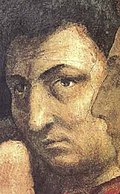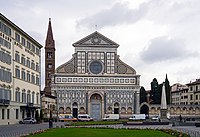File:Masaccio trinity.jpg

Original file (531 × 1,073 pixels, file size: 121 KB, MIME type: image/jpeg)
Captions
Captions
Summary
[edit]| Masaccio: Holy Trinity
|
|||||||||||||||||||||||||
|---|---|---|---|---|---|---|---|---|---|---|---|---|---|---|---|---|---|---|---|---|---|---|---|---|---|
| Artist |
artist QS:P170,Q5811 |
||||||||||||||||||||||||
| Title |
Holy Trinity |
||||||||||||||||||||||||
| Object type |
fresco |
||||||||||||||||||||||||
| Genre |
religious art |
||||||||||||||||||||||||
| Description |
The "Trinity" was one of the first painting to show a greater understanding of one point perspective in an interior space. The barrel vault shows the grandeur of Rome. Figures shown are Mary, Saint John and the petitioners on the lower step. |
||||||||||||||||||||||||
| Depicted people |
Jesus |
||||||||||||||||||||||||
| Date |
between 1425 and 1428 date QS:P571,+1425-00-00T00:00:00Z/8,P1319,+1425-00-00T00:00:00Z/9,P1326,+1428-00-00T00:00:00Z/9 |
||||||||||||||||||||||||
| Medium |
fresco medium QS:P186,Q25631150 |
||||||||||||||||||||||||
| Dimensions |
height: 667 cm (21.8 ft); width: 317 cm (10.4 ft) dimensions QS:P2048,667U174728 dimensions QS:P2049,317U174728 |
||||||||||||||||||||||||
| Collection |
institution QS:P195,Q51175 |
||||||||||||||||||||||||
| Object location |
|
||||||||||||||||||||||||
| References |
|
||||||||||||||||||||||||
| Authority file | |||||||||||||||||||||||||
| Source/Photographer |
Web Gallery of Art: reference_wga QS:P973,"http://www.wga.hu/html/m/masaccio/trinity/trinity.html" |
||||||||||||||||||||||||
| Permission (Reusing this file) |
|
||||||||||||||||||||||||
| Other versions | See Category:Trinity_(Masaccio) | ||||||||||||||||||||||||
Licensing
[edit]|
This is a faithful photographic reproduction of a two-dimensional, public domain work of art. The work of art itself is in the public domain for the following reason:
The official position taken by the Wikimedia Foundation is that "faithful reproductions of two-dimensional public domain works of art are public domain".
This photographic reproduction is therefore also considered to be in the public domain in the United States. In other jurisdictions, re-use of this content may be restricted; see Reuse of PD-Art photographs for details. | |||||
File history
Click on a date/time to view the file as it appeared at that time.
| Date/Time | Thumbnail | Dimensions | User | Comment | |
|---|---|---|---|---|---|
| current | 16:28, 1 September 2009 |  | 531 × 1,073 (121 KB) | Flekstro (talk | contribs) | A higher resolution was available from the same source ( http://www.wga.hu/html/m/masaccio/trinity/trinity.html ) |
| 09:36, 13 November 2005 |  | 380 × 767 (152 KB) | JoJan (talk | contribs) | edited image from en.wikpedia Image:Masaccio trinity.jpg |
You cannot overwrite this file.
File usage on Commons
The following 2 pages use this file:
- File:Masaccio trinity.jpg
- File:Trinity Masaccio.jpg (file redirect)
File usage on other wikis
The following other wikis use this file:
- Usage on bg.wikipedia.org
- Usage on bs.wikipedia.org
- Usage on ca.wikipedia.org
- Usage on cs.wikipedia.org
- Usage on en.wikipedia.org
- Usage on eo.wikipedia.org
- Usage on es.wikipedia.org
- Usage on et.wikipedia.org
- Usage on eu.wikipedia.org
- Usage on fr.wikipedia.org
- Usage on gl.wikipedia.org
- Usage on he.wikipedia.org
- Usage on hr.wikipedia.org
- Usage on hu.wikipedia.org
- Usage on hy.wikipedia.org
- Usage on it.wikipedia.org
View more global usage of this file.
Metadata
This file contains additional information such as Exif metadata which may have been added by the digital camera, scanner, or software program used to create or digitize it. If the file has been modified from its original state, some details such as the timestamp may not fully reflect those of the original file. The timestamp is only as accurate as the clock in the camera, and it may be completely wrong.
| JPEG file comment | MASACCIO
(b. 1401, San Giovanni Valdarno, d. 1428, Roma) Trinity 1425-28 Fresco, 667 x 317 cm Santa Maria Novella, Florence This is the most famous work of Masaccio beside the frescoes in the Cappelle Brancacci. There are various opinions as to exactly when this fresco was painted between 1425 and 1428. It was described in detail by Vasari in 1568, who emphasized the virtuosity of the "trompe l'oeil" in the architectural structure of the painting: "a barrel vault drawn in perspective, and divided into squares with rosettes which diminish and are foreshortened so well that there seems to be a hole in the wall." Only two years after Vasari's book was published, the erection of a stone altar caused the fresco to be covered up by a panel of the Madonna of the Rosary painted by Vasari himself. Thus the fresco remained unknown for further generations from 1570 to 1861 when owing to the removal of the 16th century altar it was again uncovered. After being removed and placed on the internal facade of the church between the left and the central doors, it was put back in its original position in 1952, as a result of the discovery, beneath the 19th century neo-Gothic altar, of the lower section of the fresco with Adam's skeleton and the painted altar table, once part of the whole work. The reconstructed work was taken up by critics as the symbol and revelation of Brunelleschi's principles in architecture and the use of perspective, to the point that some believed Brunelleschi to have had a direct hand in the work. The most likely interpretation of the Trinity is that the painting alludes to the traditional medieval double chapel of Golgotha, with Adam's tomb in the lower part (the skeleton) and the Crucifixion in the upper part. But it can also assume the significance of the journey the human spirit must undertake to reach salvation, rising from the earthly life (the corruptible body) through prayer (the two petitioners) and the intercession of the Virgin and saints (John the Evangelist) to the Trinity. A close-up view of the skeleton in the sarcophagus also revealed the ancient warning, in clear letters: I WAS WHAT YOU ARE AND WHAT I AM YOU SHALL BE.
Author: MASACCIO Title: Trinity Time-line: 1401-1450 School: Italian Form: painting Type: religious |
|---|


